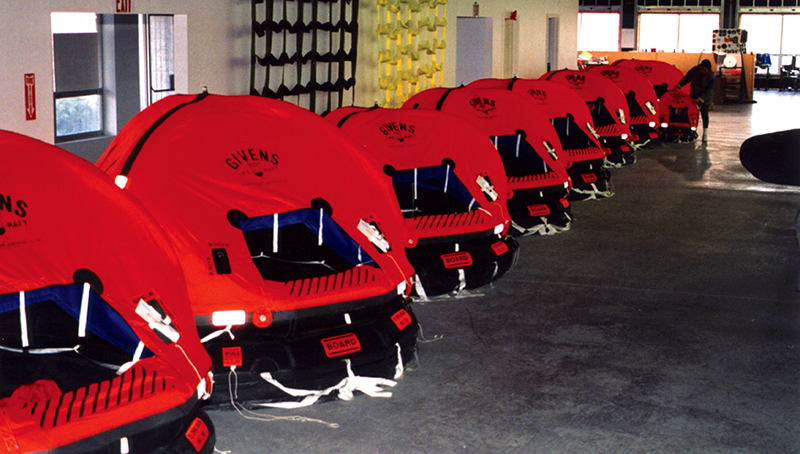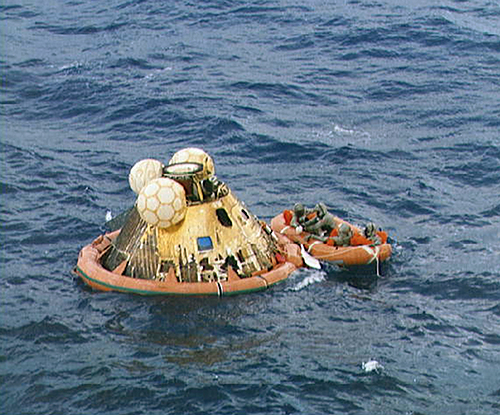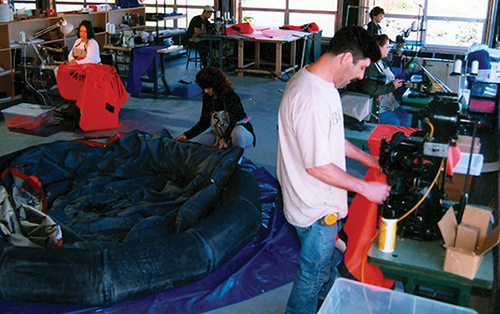
Apollo-Era Life Rafts Save Hundreds of Sailors
Originating Technology/NASA Contribution
The space shuttle is unique among spacecraft in that it glides back to Earth and lands like an airplane, usually touching ground near where it launched at Kennedy Space Center, but sometimes, in poor weather, gliding into the back-up landing site at Dryden Flight Research Center and then catching a ride back to the Cape on the back of a modified Boeing 747. Before NASA began flying the shuttle, though, astronauts had a longer, more involved trip back to base after a mission. Their capsule, called the command module, would plunge through the atmosphere before releasing a series of parachutes that would slow the craft enough for it to land on the water without too significant of an impact. Called a splashdown, this type of landing put the astronauts out in the ocean, where a specially designated U.S. Navy ship would then deploy a helicopter to retrieve the space travelers. Waiting for the rescue, the astronauts would release a highly visible marker dye into the water, then leave the command module and climb aboard a life raft.
These early space pioneers had traveled thousands of miles and then landed safely back on Earth. The journey’s end was in sight, but they had one more obstacle. The rotor downdraft from the helicopter coming to retrieve them, reaching sometimes as much as 100 knots per hour, was enough to flip a typical flat-bottomed life raft.
Not willing to be thwarted after coming so far, NASA engineers began devising a solution. They knew they needed a highly stable inflatable raft capable of riding out the rough winds, and the solution was to make use of the most abundant resource available: water. Engineers at NASA’s Johnson Space Center went to work designing and patenting a hydrodynamically stabilized ballast system that would prevent a life raft from tipping in choppy seas and fierce winds.
Partnership
While NASA was working on its rescue raft designs, inventor Jim Givens was similarly at work, designing a canopied raft with a hemispheric ballast chamber capable of withstanding the strongest winds and waves. Givens patented his similar system and then obtained an exclusive license for the patented NASA system.
Givens Marine Survival Co. Inc., of Tiverton, Rhode Island, now manufactures and markets the rescue rafts—under the name Givens Buoy Life Raft—in a variety of sizes and models for everything from sailboats to larger ocean-going vessels.
To date, Givens has sold several thousand of the ballasted inflatable life rafts, and this space-age technology is credited with saving the lives of over 450 seamen.
Product Outcome
The Givens raft, like the NASA design, relies upon a heavy, water-filled ballast. A flapper valve allows large amounts of water—hundreds of gallons—to enter the hemispheric chamber. This water provides the ballast that keeps the center of gravity constant, much like the thousands of pounds of lead keel used to stabilize sailboats. This design makes the raft nearly impossible to capsize. If, however, a large wave breaks over the top of the life raft, carrying it upside down, it is designed to somersault and right itself, the momentum of the water in the ballast chamber continuing across the top of the canopy and leveling it upright again. While not the most comfortable sensation, this feature is what keeps crews alive and out of the water.
With a typical, flat-bottomed life raft, there is little or no ballast and no momentum to help a capsized craft right itself. An inverted life raft begins to fill with seawater, increasing exponentially the risks of hypothermia or drowning. Righting the raft involves the disoriented occupants leaving the craft and attempting the procedure from outside, a task that could result in dangerous exposure to the elements and sailors being swept away.
It is not just strong winds and waves that flip the typical inflatable life raft, though. Something as simple as someone trying to climb aboard, or occupants shifting inside, could flip a standard life raft. The Givens-designed valve system, however, employs multiple stabilizers to accommodate for boarders and shifting of occupants as well as varying wave angles and swells.
Both the Navy and U.S. Coast Guard have tested the Givens Buoy Life Raft. Coast Guard testing, as part of its routine testing of all available certified marine safety gear, demonstrated that the raft could not be capsized by rough seas or strong winds. The testing included simulated rescue hoists from Coast Guard rescue helicopters, simulated hurricane force winds from a C-130 aircraft slipstream, drift tests, weight distribution and stability tests, and “at-sea” testing. In each instance, the Givens life raft withstood the most brutal of punishments.
Testing, no matter how well-designed, can never really account for all of the variables that could happen at sea, so it is the testimonials from people whose lives have been saved by these rafts that really speak to their ruggedness. In 1980, the lives of four sailors were saved by a Givens life raft. It was August and the four men were caught in the middle of Hurricane Allen, at that time the second worst storm ever recorded on the Atlantic. With winds gusting to 190 knots per hour, their 30-ton ketch capsized, and the crew sought refuge in their Givens Buoy Life Raft. The four men rode 35-foot waves over the next 42 hours before being rescued, with the raft at times being submerged under several feet of water, flipping, and then righting itself. As Bob Harvey, one of the survivors tells, “We didn’t feel comfortable, but we did feel secure.”
The standard Givens Buoy Life Raft comes equipped with water-activated lights, an automatically inflated canopy, a system for capturing rainwater, insulated floors, and an automatic inflation system.

Apollo astronauts and a Navy frogman in biological isolation garments await pickup from a helicopter.

Givens Marine Survival Co. Inc. licensed the self-righting life raft design from NASA and has since crafted thousands of the life-saving rafts.

Available in a variety of sizes, the Givens Buoy Life Raft can be used on small sailboats or large fishing vessels and fully self-inflates in under 12 seconds.













